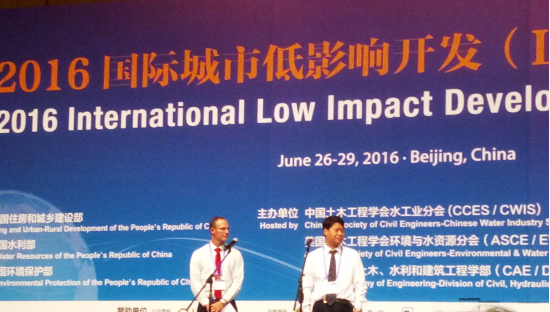2016 LID and Beijing Consensus
The 2016 LID International Conference proposed that draft of the 2016 China conference LID for urban stormwater management, the Beijing Consensus in Chinese and English: http://www.cnlid.net/nw-show-id-677.html or Download 2016 LID Beijing Consensus (draft). Read more, ….


Fig. 2016 LID Beijing Consensus was announced jointly by Chinese and American Scientists
2016 国际LID大会
城市低影响开发雨水管理——北京共识
(草案)
2016 LID-China Conference
Low Impact Development for Urban Stormwater Management
The Beijing Consensus
(Draft)
- 我们的最终目标是通过管理城市雨水径流,创建人与自然和谐的、可持续的宜居环境。
Our ultimate goal is to manage urban stormwater in such a way to create a living environment in which humanity and nature co-exist harmoniously and a sustainable condition is maintained.
- 我们认为雨水是重要的水资源,应尽最大可能加以利用,尤其是在相对干旱的地区。我们认识到对于水资源利用而言,水量和水质均为限制性的因素,因此在管理雨水径流时应当量质并举。
We consider stormwater runoff as a water resource and its beneficial use should be maximized, especially in relatively dry areas. We recognize water quantity and quality are both limiting factors to water usage. Consequently, managing stormwater should emphasize both the quantity and the quality aspects.
- 为了减少城市化带来的的负面影响,应该最大程度地保护和恢复城市区域的自然水文过程。
To mitigate the negative impact of urbanization, efforts should be made to conserve/restore the natural hydrologic processes as much as possible.
- 为了实现对城市雨水径流的量质控制,我们应当兼顾自然水文过程(如入渗、蒸发等)和人工强化工程措施(如低影响开发LID设施、绿色基础设施)的联合使用。
In controlling urban runoff quantity and quality, we should consider the combined use of both natural (such as infiltration, evapotranspiration, etc.) and engineered (such as low impact development (LID) or green infrastructure (GI) practices) processes and systems.
- 我们认识到在极端暴雨情况下,绿色基础设施和灰色工程设施的统筹使用和相互耦合是必要的。
We realize under certain situations (e.g. extreme rainfall events), the integration of green and gray infrastructures might be necessary.
- 我们认为需要将城市土地用途管理与城市水管理规划联系起来,统筹解决城市水问题。有效而可持续的城市雨水径流管理需要强有力的法规制度作保障。
We recognize the need to link land uses with urban water management plans. An effective and sustainable urban stormwater management requires a solid regulatory framework.
- 我们认识到,对于城市雨水径流管理设施的规划和设计,需要统筹分析城市汇水区内的各种自然、社会交互影响关系,并合理使用流域数字化水文分析模拟模型等工具。
We understand there may be consequences of urban runoff management planning and design, e.g., upstream impacting downstream (connectivity). A watershed-wide consideration is encouraged and tools for such analysis, e.g., watershed hydrologic models, are needed.
- 城市降雨径流管理需要多专业融合、多部门协作,需要政府、企业、社会长期全面的参与和支持。控制目标的设定和适用技术的选用要因地制宜,以实际问题为导向。
More often than not, the urban stormwater management may involve multiple jurisdictions and agencies. Therefore it is highly desirable that a strong collaboration exists among various relevant agencies, institutions, groups, etc. (stakeholders) on a continuing basis. Moreover, setting up goals and selecting appropriate techniques for achieving them should consider local and/or regional conditions.
- 我们认识到构建城市低影响开发雨水管理系统需要长期的坚持和投入,应考虑政府和社会资本合作(PPP)及其他经济有效的运作方式。同时要加强从规划、设计、施工、验收和运行维护的全生命周期管理。
We realize that urban runoff management requires a significant and long-term commitment and investment. Public-private partnerships and other cost-effective strategies should be considered. Also, life-cycle operation and management of practices, such as planning, design, construction, inspection/acceptance, etc. are needed.
- 我们需要不断创新和锐意进取,我们也要致力于可持续地推动知识和经验的共享。
We need to make constant innovation and improvement. We will make great efforts to promote the sharing the knowledge and experiences on a continuous basis.
( http://www.cnlid.net/nw-show-id-677.html ).
